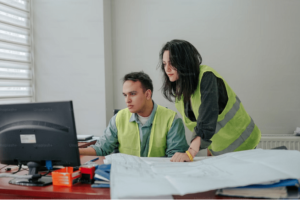
In the fast-paced world of logistics, efficiency is key to success. The integration of advanced technologies has revolutionized the way businesses manage their supply chains, with two powerful tools, GPS (Global Positioning System) and the Internet of Things (IoT), playing pivotal roles. This article delves into the synergistic relationship between GPS and IoT and how their integration is transforming logistics management, optimizing routes, enhancing tracking capabilities, and ultimately improving overall efficiency.
The fusion of GPS and IoT technologies represents a groundbreaking leap forward in the realm of logistics management. This dynamic synergy empowers businesses to navigate the complexities of modern supply chains with unprecedented precision, efficiency, and foresight.
The enhanced tracking capabilities offered by the integration of GPS and IoT provide real-time visibility into the movement, status, and condition of goods throughout the supply chain. This visibility, in turn, translates into more informed decision-making, allowing logistics managers to proactively address issues, minimize delays, and optimize routes for increased efficiency.
Furthermore, the predictive analytics facilitated by this collaboration enable logistics companies to implement proactive maintenance strategies, reducing the risk of vehicle breakdowns and associated disruptions. This not only enhances operational reliability but also contributes to cost reduction and sustainability by minimizing downtime and optimizing resource usage.
Here are the roles of IOT in Logistic Management
- Understanding GPS in Logistics: GPS technology has been a game-changer in logistics by providing real-time location data for vehicles, shipments, and assets. It enables accurate tracking, route optimization, and efficient fleet management. GPS has become an indispensable tool for logistics companies, helping them monitor the movement of goods and vehicles with precision.
- The Rise of IoT in Logistics: The Internet of Things (IoT) involves connecting devices and sensors to the Internet to collect and exchange data. In logistics, IoT devices can be embedded in trucks, containers, and packages, generating a wealth of information. These devices can monitor factors such as temperature, humidity, shock, and even the condition of goods during transportation.
- Synergy Unleashed: GPS and IoT Integration: When GPS and IoT technologies join forces, logistics management reaches new heights. Integrating IoT sensors with GPS-enabled devices creates a dynamic system that not only tracks location but also provides valuable data on the condition of goods. For example, a GPS-enabled truck with IoT sensors can transmit real-time information about the temperature of a refrigerated container or detect if a package has been subjected to rough handling.
- Enhanced Tracking and Visibility: The combination of GPS and IoT enhances tracking capabilities, offering real-time visibility into the entire supply chain. Logistics managers can monitor the location, status, and condition of shipments at any given moment. This increased visibility allows for proactive decision-making, minimizing delays, and addressing issues promptly.
- Optimized Route Planning: GPS has long been used for route optimization, considering factors such as traffic and distance. IoT adds another layer by providing real-time data on road conditions and potential obstacles. Smart algorithms can process this information to dynamically adjust routes, avoiding congestion, road closures, or adverse weather conditions.
- Predictive Analytics for Maintenance: IoT sensors can monitor the health of vehicles and equipment in real time. Combined with GPS data, logistics companies can implement predictive maintenance strategies, identifying potential issues before they lead to breakdowns. This proactive approach minimizes downtime and reduces the risk of unexpected disruptions in the supply chain.
- Cost Reduction and Sustainability: The synergy between GPS and IoT not only improves efficiency but also contributes to cost reduction and sustainability. Optimized routes lead to fuel savings, and predictive maintenance reduces repair costs. Moreover, enhanced visibility enables better inventory management, reducing the likelihood of overstocking or stockouts.
- Challenges and Considerations: While the integration of GPS and IoT brings numerous benefits, logistics companies must address challenges such as data security, standardization, and the need for skilled personnel to manage these sophisticated systems. Striking the right balance between innovation and security is crucial for successful implementation.
- Conclusion: The synergy between GPS and IoT is reshaping the landscape of logistics management, offering unprecedented visibility, efficiency, and control. As technology continues to evolve, embracing these advancements becomes essential for businesses aiming to stay competitive in the dynamic world of logistics.
In conclusion, the integration of GPS and IoT is not just a technological leap; it’s a strategic move that empowers logistics companies to meet the growing demands of the modern supply chain, fostering efficiency, sustainability, and customer satisfaction.
Despite the transformative potential of GPS and IoT integration, logistics companies must navigate challenges related to data security, standardization, and the need for skilled personnel. Striking a balance between innovation and security is paramount to the successful implementation of these technologies.
As the logistics industry continues to evolve, businesses that embrace the synergistic potential of GPS and IoT will be better positioned to meet the demands of a rapidly changing landscape. This transformative alliance not only streamlines operations but also lays the foundation for a more resilient, sustainable, and customer-centric logistics ecosystem. In a world where precision and adaptability are paramount, the collaboration between GPS and IoT emerges as a strategic imperative for those aiming not just to keep pace but to lead in the future of logistics management.
You might also like our TUTEZONE section which contains exclusive tutorials on how you can make your life simpler using technology.




